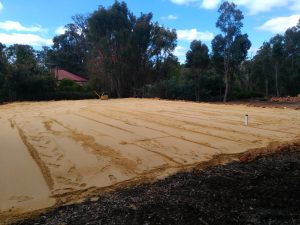You may be already used to seeing sand at the beach and may think that it has no important part in people’s lives. But did you know that the houses you live in and the streets you walk on are built using sand?
When talking about sand in building, it usually refers to the material that’s much firmer than the sand grains you’d find on the shoreline. It should also be clear of stone blocks and other contaminants.
Understanding the sand pad can be tricky for a first-time homeowner. Continue reading to learn everything there is to know about the sand pad.
Why is a sand pad required before constructing a shed or house?
You need the help of specialists, such as the Dobson Excavations in Perth, to make a proper sand pad. We work with reliable sand suppliers and certify the sand pad before putting up any structure. This is important since it will lay the foundation or groundwork for the project. You need something solid and durable for this purpose.

Different types of sand for sand Pad
Numerous varieties of sand can be utilised in construction, each for a distinct purpose. Therefore, it’s critical to understand that not all sand is the same.
Clean Fill Sand
Sand for House pads has to be certified to build the house on and must be free of any debris, Fill sand is straight of the face, which means it is Natural with small granules, and just the right amount of clay for compaction for sand pads for houses, sheds, water tanks etc.
Plaster sand
Also known as rendering sand used for exterior wall rendering, once combined with the ratio of water and cement has great adhering characteristics, it can also be used to set paving.
Brickies sand
This sand has a content of clay and fines for a more workable sand, it is used in mortar for brick laying and also can be used in Limestone Block construction.
Paving sand
Used in shaping, screeding and sculpting, compromise between both Plaster and Brickie sand. Has strong compaction and setting strength, without even using little or no cement or bonding products.
Compacting the sand pad
In a construction project, sand compaction involves using mechanical force to densify a soil by minimising the space between sand grains. The key objective of the procedure is to create a solid working foundation, so experts must complete it with the appropriate skills and equipment.
Soil compaction equipment comes in a variety of styles and combinations, such as the number of drums and vibratory system. All types result in increased soil density, which boosts the supporting power of the soil.
These machines have rubber tyres that are separated and have varying air pressure. They usually have ballast mechanisms that adjust weight as needed to achieve compaction requirements.
Compactor
Used to compact sand pads, it has a metal compactor plate, which in combination with the vibration of the plate compacts the sand. Used on each layer of sand to compact the pad, so that when a penetrometer is used it will determine the compaction and if it is suitable to build on.
Smooth rollers
These machines use static pressure to compress dirt, sometimes in combination with vibration. Smooth rollers are most likely used to generate a smooth construction area in the finishing compaction process. Can be used on smaller sand pads and driveways.
Conclusion
If you’re sand pad is not correctly compacted then you foundation of sand could cause house movement after building, or concrete slab issues where it could crack.
The expense and labour of an adequately completed sand pad during the early construction process are small compared to the potential negative impacts later on. As a result, employing professionals to complete the sand pad is always a great choice.
If you live in the Perth, Peel or South West, consult with Dobson Excavations. We will provide a solution for all of your construction requirements, including hiring the necessary machinery and expertise. Simply contact us via our website, and we will gladly assist you.
